Dental Instruments: Names and Pictures PDF Guide
We’ll delve into the essential dental instruments‚ exploring names and pictures conveniently compiled in a PDF format‚ offering a concise overview of these tools for easy reference and study.
Walking into a dental clinic can be daunting‚ especially when confronted with an array of unfamiliar instruments. This guide aims to demystify those tools‚ providing a comprehensive overview of dental instruments‚ their names‚ and their uses. Understanding these instruments is crucial for dental professionals and can also alleviate patient anxiety by familiarizing them with the equipment used during procedures.
From basic examination tools like mirrors and probes to more specialized surgical and hygiene instruments‚ this resource covers a wide range of dental equipment. Each instrument plays a vital role in diagnosing‚ treating‚ and preventing oral health issues. By exploring the names and pictures of these instruments‚ readers will gain a better understanding of their functions and how they contribute to overall dental care.
Whether you’re a dental student‚ a practicing dentist‚ or simply a curious patient‚ this guide serves as a valuable resource for navigating the world of dental instruments.
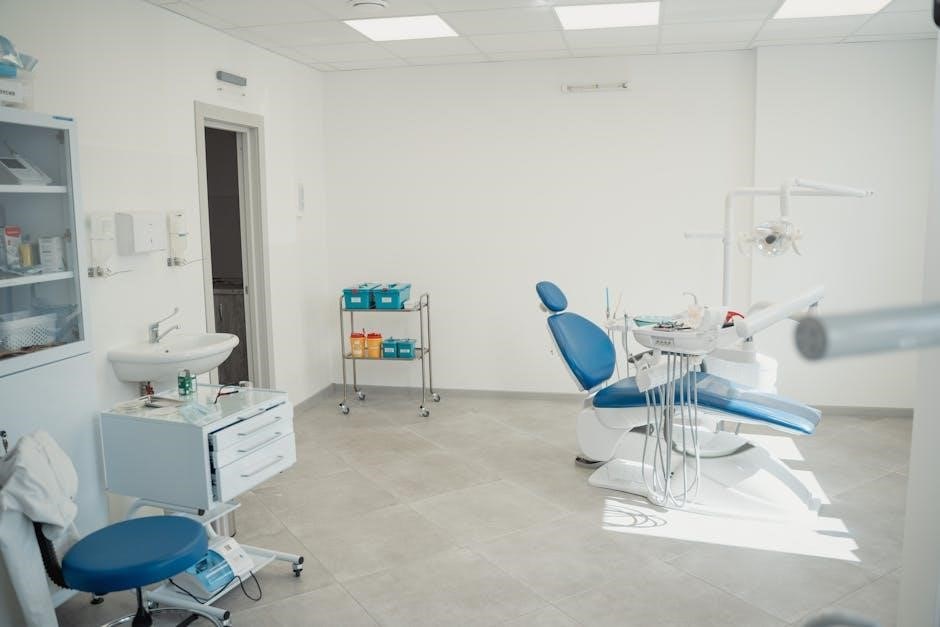
Basic Dental Examination Instruments
Before any dental procedure‚ a thorough examination is carried out. Several key instruments are used during this process‚ allowing the dentist to accurately assess the patient’s oral health condition.
Dental Mirror
The dental mirror is a fundamental instrument in any dentist’s toolkit. It serves multiple crucial purposes during an oral examination. Primarily‚ it provides indirect vision‚ allowing the dentist to view areas of the mouth that are otherwise difficult or impossible to see directly. This includes the lingual surfaces of teeth‚ distal areas‚ and other hard-to-reach spots.
Beyond indirect vision‚ the dental mirror also functions as a retractor. It’s used to gently move the tongue‚ cheeks‚ and lips‚ providing a clear field of view for examination and treatment. Retraction is essential for optimal visibility and access to the teeth and surrounding tissues.
Furthermore‚ the dental mirror can be employed for illumination. By reflecting light onto specific areas of the mouth‚ the dentist can enhance visibility and detect subtle abnormalities. This is particularly helpful when searching for early signs of decay or other oral health problems.
Probe/Explorer
The probe‚ also known as an explorer‚ is another essential diagnostic instrument used in dentistry. Its primary function is to detect and assess the texture and integrity of tooth surfaces. Dentists use the probe to identify areas of decay‚ check for the presence of calculus (tartar)‚ and evaluate the margins of restorations.
The probe typically features a slender‚ pointed tip that allows for precise tactile examination. By gently running the tip along the tooth surface‚ the dentist can discern subtle irregularities or changes in texture that may indicate underlying problems. A “sticky” sensation or a catch at the margin of a filling often signals the presence of decay.
Probes are available in various shapes and sizes to accommodate different areas of the mouth and specific diagnostic needs. Some probes are calibrated with markings to measure pocket depths around the teeth‚ aiding in the diagnosis and management of periodontal disease. Careful and thorough exploration with a probe is crucial for early detection and prevention of dental issues.
Tweezer
Dental tweezers‚ also known as cotton pliers‚ are indispensable instruments in a dentist’s toolkit‚ primarily used for grasping and manipulating small objects within the oral cavity. Unlike standard tweezers‚ dental tweezers are designed with specific features to aid in dental procedures. They have long‚ slender beaks that allow access to tight spaces‚ and their tips can be smooth or serrated to provide a secure grip on various materials.
Dentists commonly use tweezers to place or remove cotton rolls‚ gauze‚ and other absorbent materials used to control moisture during procedures. They are also essential for handling small items like medication pellets‚ wedges‚ and articulating paper used for checking a patient’s bite.
The precise control and maneuverability offered by dental tweezers make them invaluable for maintaining a clean and efficient working environment. By facilitating the handling of small objects without direct hand contact‚ they also help to maintain asepsis and prevent contamination during dental treatments.
Surgical Instruments
Surgical instruments are vital for various procedures‚ including extractions and implant placement. Sterilization is crucial to prevent infections; clean instruments before sterilizing. Explore quality German-forged instruments utilized by surgeons globally for decades.
Scalpel
The scalpel‚ a quintessential surgical instrument‚ features a sharp blade designed for precise incisions during various dental procedures. As a fundamental surgical tool‚ it ensures clean and controlled cuts‚ minimizing tissue trauma. The blades are crafted to effortlessly cut through material‚ offering the surgeon optimal control and accuracy.
Available in various sizes and shapes‚ scalpels cater to diverse surgical needs‚ ensuring the right tool for each specific task. Proper handling and sterilization are paramount‚ maintaining a sterile field and preventing infections. Qualified technicians produce these instruments for use in different areas of surgery.
The scalpel’s ergonomic design and sharp cutting edge make it indispensable for achieving optimal surgical outcomes in dental practices. Always sterilize surgical instruments prior to surgery to prevent infection and ensure patient safety.
Curettes
Curettes are indispensable surgical instruments used extensively in dental procedures for scraping or debriding tissue. These instruments are particularly useful in removing inflamed tissue or lesions from bone cavities. A double-ended surgical curette‚ such as a periapical surgical or bone curette‚ features a mirror image design for versatility.
Crafted with precision‚ curettes come in various shapes and sizes to suit different surgical needs. Dental professionals rely on curettes to meticulously clean and shape bone surfaces during oral surgeries. The design of the curette allows for controlled and precise removal of unwanted tissue‚ promoting optimal healing.
Proper sterilization of curettes is vital to prevent infection and ensure patient safety. The efficacy and versatility of curettes make them essential tools in modern dental surgical practices. Utilizing high-quality materials ensures durability and reliability.
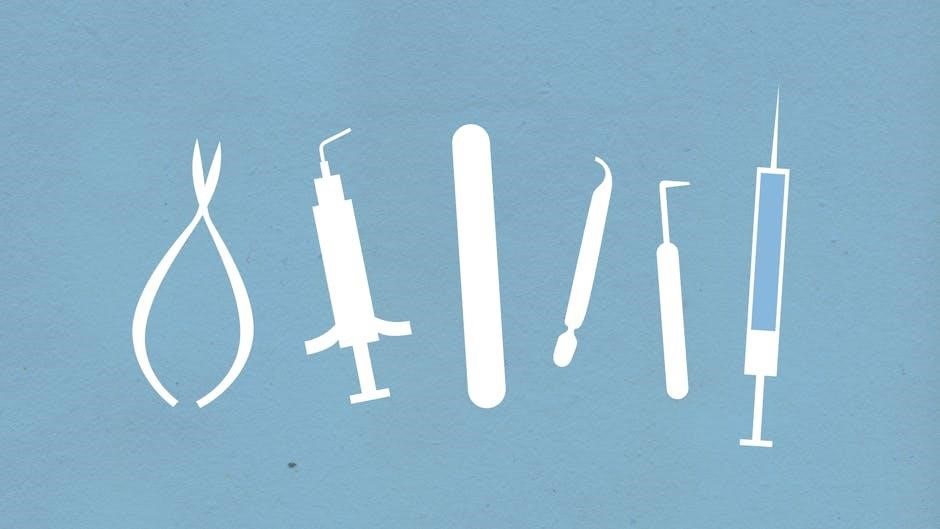
Hygiene Instruments
Hygiene instruments are vital in maintaining oral health. They include scalers and probes‚ crafted with precision tips and SmartSharp Technology‚ ensuring effective and comfortable dental hygiene procedures for patients.
Scalers
Scalers are indispensable dental instruments specifically designed for removing calculus and plaque from tooth surfaces. These precision tools are essential for maintaining optimal oral hygiene. Different types of scalers exist‚ each tailored for specific areas of the mouth and types of deposits. Sickle scalers‚ for example‚ feature a sharp‚ pointed tip ideal for removing supragingival calculus‚ which is calculus located above the gum line. Curettes‚ on the other hand‚ have a rounded toe and back‚ making them suitable for subgingival scaling‚ removing calculus from below the gum line.
Proper use of scalers requires skill and precision to avoid damaging the tooth structure or soft tissues. Dental professionals undergo extensive training to master scaling techniques‚ ensuring effective and safe removal of deposits‚ ultimately preventing periodontal disease and promoting healthy gums. Regular scaling is a crucial component of preventive dental care.
Probes and Explorers
Probes and explorers are fundamental diagnostic instruments in dentistry‚ playing a crucial role in assessing the health of teeth and surrounding tissues. Explorers‚ with their sharp‚ pointed tips‚ are used to detect surface irregularities on teeth‚ such as cavities or defective margins of restorations. The tactile sensitivity of an explorer allows dentists to identify subtle changes in tooth structure‚ aiding in early caries detection.
Probes‚ on the other hand‚ are used to measure the depth of periodontal pockets‚ the space between the tooth and gum. This measurement helps assess the severity of gum disease. Graduated markings on the probe enable accurate readings‚ guiding treatment decisions. Both probes and explorers are essential for thorough dental examinations and contribute significantly to preventative care and early intervention.
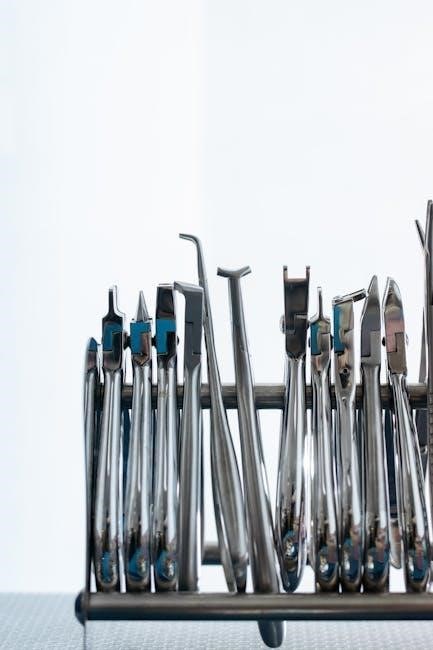
Instruments for Amalgam Manipulation
Essential instruments for amalgam placement include the amalgam carrier for delivery and the amalgam condenser (plugger) for packing the material into the prepared tooth cavity‚ ensuring a dense restoration.
Amalgam Carrier
The amalgam carrier is a double-ended instrument designed for efficiently carrying and dispensing amalgam material into a prepared tooth cavity. Its primary function is to facilitate the placement of amalgam‚ a dental restorative material composed of a mixture of metals‚ into the prepared tooth structure during a filling procedure. The instrument features a hollow cylinder or well at each end‚ which can be filled with the amalgam.
The amalgam carrier allows the dentist to accurately and quickly transfer the material to the cavity‚ minimizing contamination and ensuring proper placement. The dentist uses a lever or plunger mechanism to eject the amalgam from the carrier into the prepared tooth. Different sizes of carriers accommodate varying cavity dimensions. This instrument is an indispensable tool.
Amalgam Condenser (Plugger)
The amalgam condenser‚ also known as a plugger‚ is a fundamental dental instrument utilized to compact and condense amalgam material into a prepared tooth cavity during restorative procedures. Its primary function is to apply pressure to the freshly placed amalgam‚ ensuring it adapts intimately to the cavity walls and eliminates any voids within the restoration. This process is essential for achieving a dense‚ durable‚ and long-lasting filling.
Amalgam condensers come in various sizes and shapes‚ each designed to accommodate different cavity sizes and locations within the mouth. The working end of the instrument is typically flat or rounded and may be serrated to enhance condensation. Dentists use the condenser with firm‚ controlled pressure to pack the amalgam tightly into the prepared space‚ creating a solid and stable restoration.
Digital Dental Instruments
Explore the world of digital dentistry‚ showcasing modern tools like digital sensors for capturing images in place of X-ray films‚ revolutionizing diagnostics and treatment planning in contemporary dental practices.
Digital Sensor
The digital sensor is a cutting-edge tool in modern dentistry‚ designed to replace traditional X-ray films. Its primary function is to capture digital images of teeth and surrounding structures with remarkable clarity and precision.
This innovative device is strategically placed inside the patient’s mouth‚ where it instantaneously records detailed radiographic images. These images are then displayed on a computer screen‚ allowing dentists to promptly diagnose and assess dental conditions.
Unlike conventional X-rays‚ digital sensors significantly reduce radiation exposure for patients‚ enhancing safety during diagnostic procedures. Moreover‚ they offer the advantage of immediate image availability‚ eliminating the waiting time associated with film development.
The enhanced image quality allows for better diagnostics. Digital sensors are integral to modern dental practices‚ facilitating accurate diagnoses and improving overall patient care through advanced technology. They contribute to streamlined workflows‚ reduced radiation exposure‚ and enhanced diagnostic capabilities.
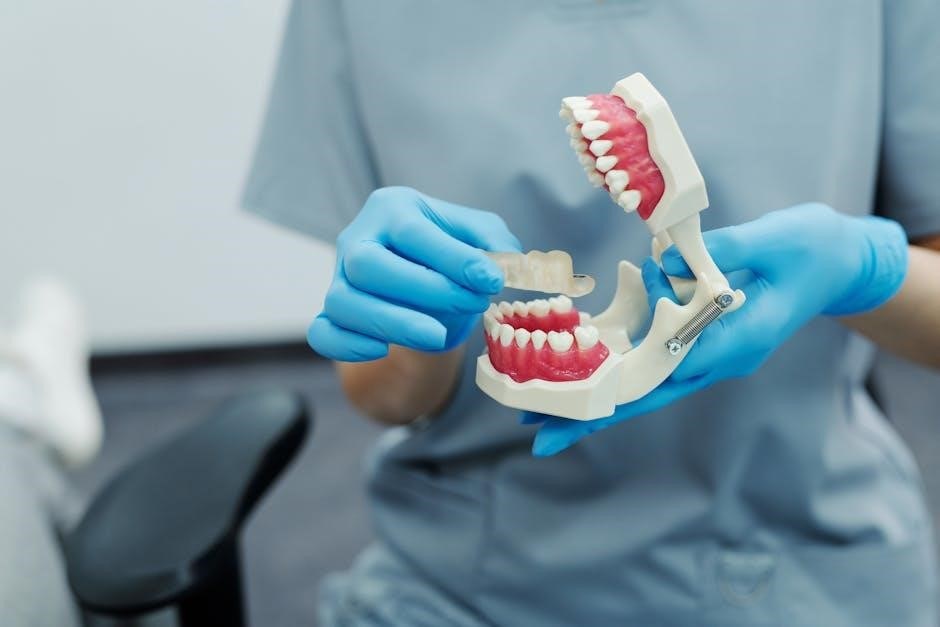
Where to Find Dental Instruments PDF Catalogs
Locating comprehensive dental instruments PDF catalogs is essential for dental professionals seeking detailed information on available tools and equipment. Several avenues offer access to these valuable resources.
Firstly‚ many leading dental supply companies provide PDF catalogs on their official websites. These catalogs typically feature high-quality images‚ detailed product descriptions‚ and specifications‚ aiding in informed purchasing decisions.
Professional dental associations and organizations often maintain online libraries or resource centers where members can download PDF catalogs from various manufacturers. Trade shows and dental conferences are also excellent opportunities to collect physical or digital catalogs directly from vendors.
Additionally‚ online platforms specializing in medical and dental equipment may host collections of PDF catalogs‚ allowing for convenient browsing and comparison of different products. Utilizing search engines with specific keywords like “dental instruments PDF catalog” can also yield relevant results.
Exploring these diverse resources ensures access to the latest information.
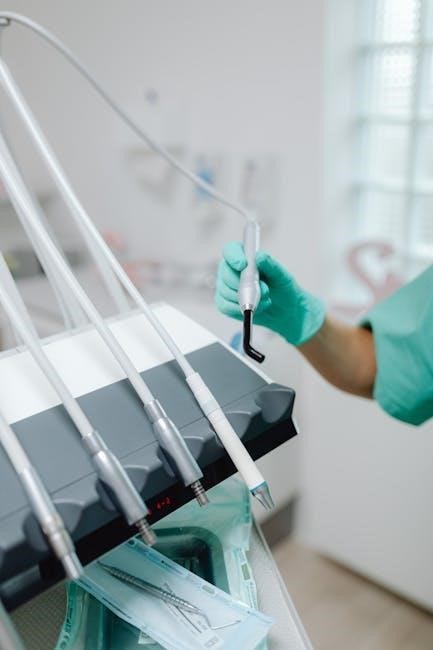
No Responses